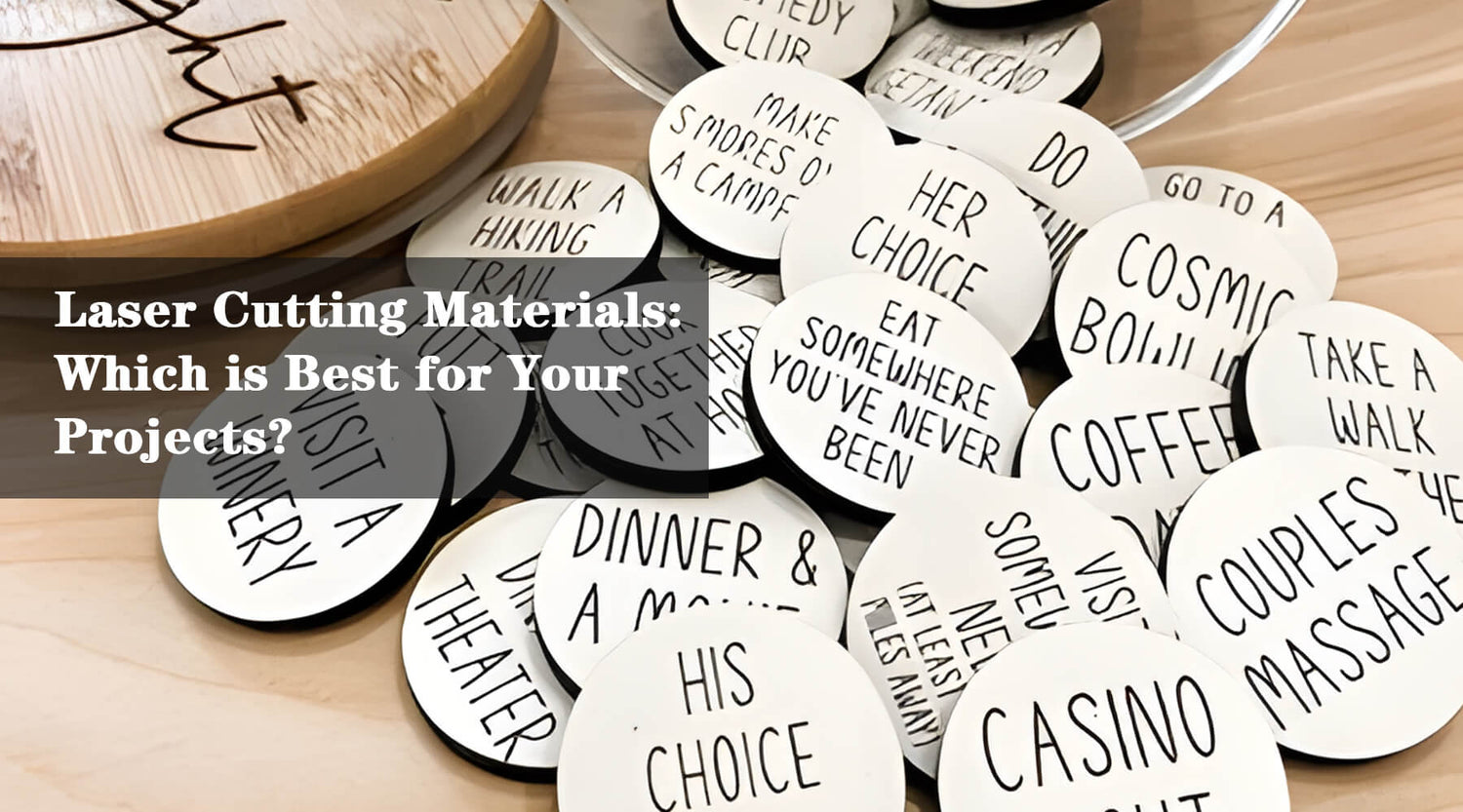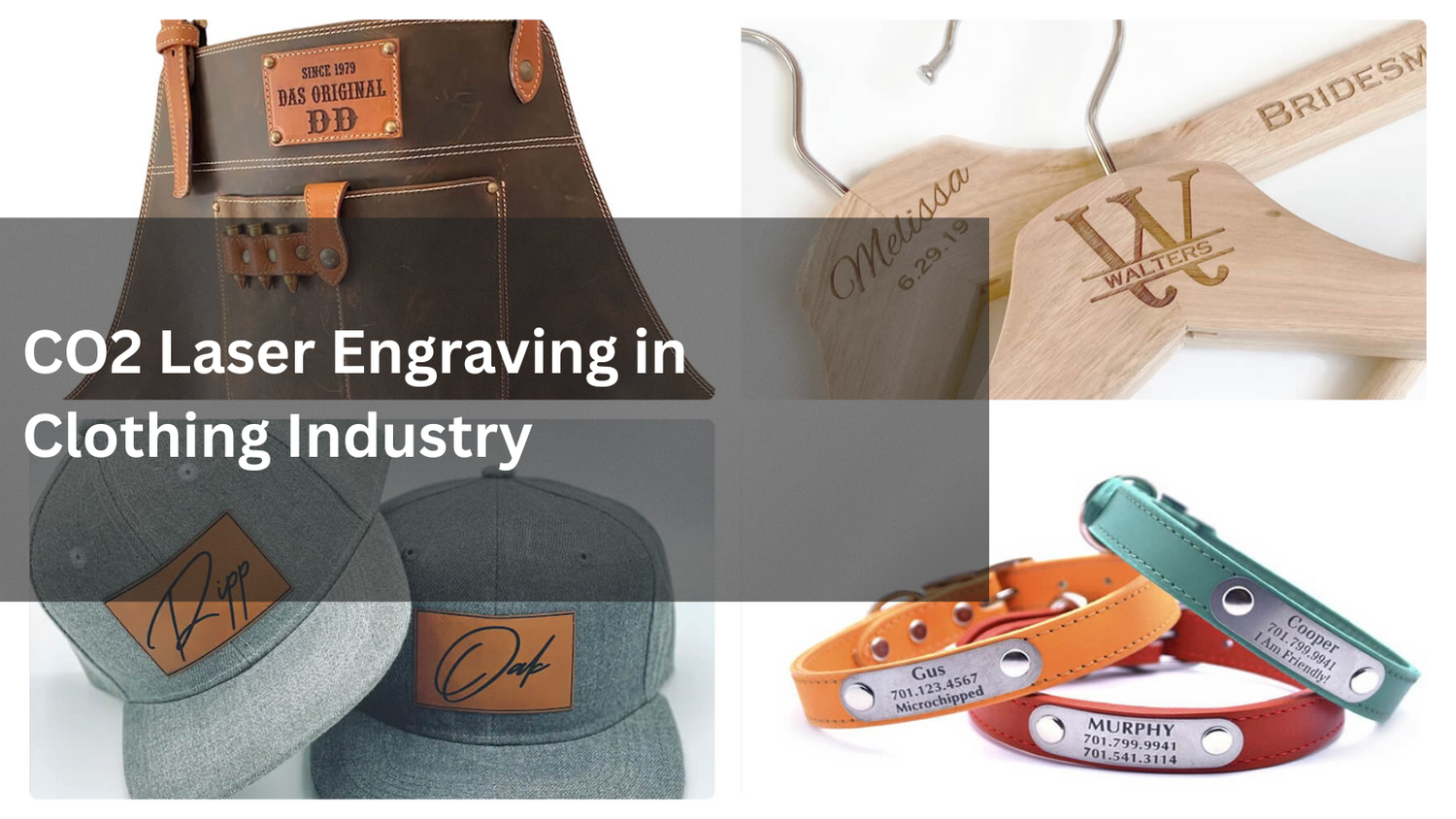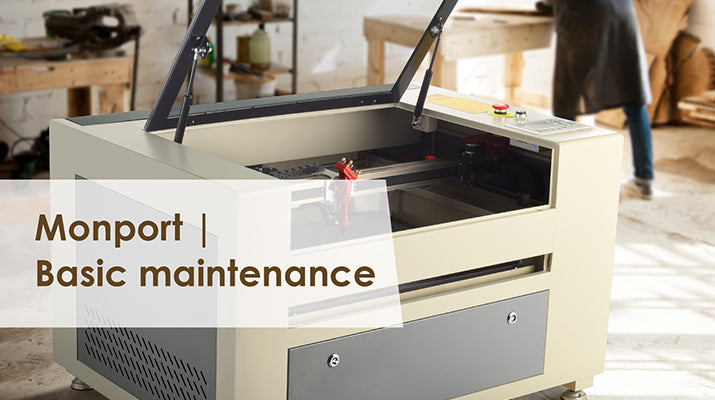60W (16''x24'') AutoFocus CO2 Laser Engraver
Laser Cutting Materials: Which is Best for Your Projects?
When using laser cutting for the first time, you might feel a little overwhelmed. How can you help? What supplies ought you to employ? How far into the material can your machine cut? Which laser cutting materials list are best for cutting various materials? Choosing the right laser cut material is crucial for achieving clean results and protecting your machine. Laser cutting and engraving machines provide a variety of options for creating personalized items. Although laser cutting wood is common, it is not the only material that can be used. There are numerous laser cutting materials available. Just make sure that the laser cutting materials list you choose is appropriate for your most commonly used materials when making your selection. Materials that can be cut can also be carved. Knowing how deep your machine can cut materials can help you perform engraving work more effectively. What is Laser Cutting? Laser cutting is a process that uses a laser beam to cut through materials, such as metal, plastic, wood, or textiles. The laser beam is focused and intense enough to vaporize or melt the material, creating a clean and precise cut. The process is typically performed by a computer numerical control (CNC) system that controls the movement of the laser and sets the cutting parameters. The type of laser cut material you select will affect your cutting speed and precision. Laser engraving, on the other hand, is a process that uses a laser beam to etch or mark a surface. The laser beam removes material from the surface, leaving behind a permanent, engraved image. The process is typically used to add text, logos, or graphics to a variety of materials, such as metal, plastic, glass, or wood. Unlike laser cutting, laser engraving does not result in the removal of material, but instead creates an indentation or mark on the surface. Best Laser Cutter Materials 1. Wood for Laser Cutting One of the most popular laser cutting materials list is wood. It's common for amateurs and even experts to use a wood laser cutter to cut out assembly-line components, engrave presents, and carve intricate designs into a piece of wood. Acrylic can be cut with a laser cutter to produce some truly incredible works of art. Laser cutting materials list like plastic and acrylic are perfect for making wall art, jewelry, signs, and other items. You can choose from a wider variety of acrylics than wood, which may surprise you. Acrylic is a popular laser cut material because of its clean edge finish. 2. Plastic and Acrylic for Laser Cutting Acrylic can be cut with a laser cutter to produce some truly incredible works of art. Laser cutting materials list like plastic and acrylic are perfect for making wall art, jewelry, signs, and other items. You can choose from a wider variety of acrylics than wood, which may surprise you. Popular acrylic is plexiglass, particularly colored plexiglass. Make lovely stained-glass-inspired art. You can choose between different thicknesses, just like with wood. 3. Foam for Laser Cutting Foam plastic is also known as porous plastic, which is made of resin as the main raw material and has countless micropores inside. It is widely used as heat insulation, sound insulation, packaging materials and car hull. Commonly used foams include polyurethane, polystyrene, polyvinyl chloride, polyethylene, phenolic foam, etc.Using CO2 laser can cut polymer based foam most effectively. The laser beam heats the material directly, causing it to evaporate. If the laser power is high enough, the laser beam will completely penetrate the material. When laser beam is used to cut polymer, the polymer will evaporate rapidly, thus making the edge smooth and the heat affected zone minimum. For metal based foam, fiber laser is the most effective. The fiber laser can cut thin sheets of foam (up to 1 / 8 inch or 3 mm). Ceramic based foam is usually not cut by laser because it is very brittle and may crack. 4. Metal for Laser Cutting Laser metal cutting can be a little challenging. Use thinner parts and the powerful Monport 50w marking machine to cut the metal completely if you want to do so. The metal will be distorted by the general co2 laser engraving. Metal sheets are often selected as a laser cut material for precision parts. 5. Leather for Laser Cutting The surface of the hook line cannot be yellow, the material background must be carved, the cutting edge of the leather cannot be black, and the engraving must be clear. These are the requirements for the laser engraving machine process. Laser cutting materials list like synthetic leather, PU leather, PVC artificial leather, leather wool, semi-finished goods, various leather fabrics, etc. can be engraved with a laser engraving machine. 6. Cardboard for Laser Cutting When compared to other materials, cardboard has a significant cost advantage. Because of its widespread use in the global packaging industry, its cost as a raw material is low. Cardboard is lightweight, quick to transport, and inexpensive. In terms of laser cutting, corrugated cardboard's unique internal structure allows it to be cut quickly, making it one of the materials with the lowest cost of laser cutting time. What Materials Should Not be Cut with a Laser Cutter? A laser engraving machine can cut wood, paper, cork, and some plastics and other materials. Wood, cardboard, aluminum, stainless steel, plastic, marble, stone, ceramic tile, and glass can all be laser engraved. However, some materials should not be laser cut or engraved. These materials will not only emit a large number of harmful substances that will harm your body during the laser engraving process, but their flammability will cause fires and other safety incidents, endangering your safety and damaging your equipment. Furthermore, the cutting ability of these materials is subpar. To avoid mishaps, keep in mind that the following materials are not suitable for laser cutting and engraving. For laser cutting materials list that cannot be cut or carved, please refer to our blog: What Materials cannot be Cut by Laser Machine? 1. PVC 2. PVB 3. Polycarbonate 4. Phenolic Resins 5. Fluoriane(Teflon, PTFE, etc.) Laser Cutter Settings for Different Materials Wattage Parameter Settings 1/16 in 1/8 in 1/4 in 1/2 in 3/4 in 1 in 1.2 in 1.4 in material 60w Speed (mm/s) 16 12 6 4 2 Baltic Birch Plywood Power 20% 25% 32% 45% 50% 80w Speed (mm/s) 25 12 7 5 4 3 Power 20% 25% 30% 35% 43% 47% 100w Speed (mm/s) 30 15 7 6 5 4 2 Power 20% 25% 28% 35% 40% 45% 55% 130w Speed (mm/s) 35 16 8 7 6 5 3 2 Power 18% 25% 27% 32% 37% 42% 47% 55% 150w Speed (mm/s) 40 17 9 8 7 6 4 2 Power 18% 24% 26% 30% 35% 40% 45% 52% 60w Speed (mm/s) 20 13 4 Leather Power 20% 28% 35% 80w Speed (mm/s) 25 18 6 4 Power 18% 28% 32% 40% 100w Speed (mm/s) 35 23 8 5 Power 18% 25% 30% 38% 130w Speed (mm/s) 40 25 9 6 Power 17% 24% 28% 37% 150w Speed (mm/s) 45 26 10 7 Power 17% 23% 27% 35% Read More: Laser Engraving & Cutting Leather Conclusion A laser machine can cut a wide variety of the laser cutting materials list. We've gone over some of the most common materials that can be laser cut, so you can choose them with confidence for your projects. Make sure to pick the right laser cut material to get the best results and preserve your equipment. We hope that this article has helped you choose the right material and its optimal settings.
Read more60W (16''x24'') AutoFocus CO2 Laser Engraver
CO2 Laser Engraving in Clothing Industry
Due to the popularity of various personalized clothes, laser engraving clothes is becoming more and more popular among fashion designers who want to create unique designs. With the development of the clothing industry, all kinds of materials can be used in clothing, not only cloth or leather, but also some other metal materials or plastic materials can be reflected in some clothing. A laser engraving machine can meet your various customized needs. Laser engraving is a good way to create a brand for your small clothing enterprises. You can use laser machine to brand your products, as well as your events. Many people use laser machine for this purpose, so don't be afraid to do it yourself! Among the numerous clothing production machines, why is the laser engraving machine increasingly becoming the choice of many designers and niche designer brands ? The engraving process of laser cutter is better than screen printing, embroidery, heat transfer and vinyl, because it is permanent and lasts for a long time. When you use a laser cutter, your design will be burned into the fabric or leather, so it will not peel off like other types of printing. Your design will also look clear, rather than blurring or fading over time as other methods do. Compared with traditional patterns of printing, jacquard, embroidery and other fabrics, laser etching patterns have many advantages. The traditional fabric weaving process has high cost, complex process and high price, while the laser carving fabric pattern operation process is simple and fast. A simple pattern can be completed in 5 minutes, saving time and labor, and the cost is also low. The most important thing is that the pattern of laser engraved fabric really meets the customer's "private customization" requirements. One or two pieces can be completed immediately, unlike printing and jacquard, which generally require mass production. It is no exaggeration to say that CO2 lasers have proven to be the most suitable technology for the fashion industry. It’s no exaggeration to say that CO2 lasers have become the most suitable technology for modern fashion design. With clothing laser engraving, you can achieve precise, millimeter-accurate patterns while reducing energy consumption and avoiding the use of water or chemicals. This makes the process more eco-friendly and sustainable than traditional decorative methods. In addition, Monport laser engravers enable faster and more efficient engraving and cutting of various fabrics. Laser processing is non-contact and tool-free, which means the textiles remain undistorted during the process. The laser beam melts the material to create fiber-free, sealed edges—resulting in a clean finish without fabric deformation. In addition, Monport laser engraver can achieve faster and more efficient carving and cutting of knitted fabrics. Laser processing is a non-contact, tool free process. In the laser cutting process, the textiles and fabrics that are cut and carved will not be contacted. Therefore, the textile will not warp due to the tearing force. The laser beam melts the material to produce a fiber free, clean and perfectly sealed edge, which is not only a neat edge, but also the whole fabric will not have deformation and other problems. What are the specific applications of laser engraving technology in the clothing industry? Hat leather patch laser etching Shops that specialize in custom leather patches for hats are rapidly growing in popularity. With clothing laser engraving, you can craft patches with initials, symbols, logos, or patterns. These patches make excellent gifts and can elevate team uniforms or personalized accessories. Jeans laser engraving Denim is ideal for clothing laser engraving due to its durability and dye variety. Using a laser is much faster than traditional embroidery and allows for beautiful, precise patterns. Just be sure to test engraving settings, as denim reacts differently based on moisture and weight. Bags laser engraving Some small online leather shops or leather handicraft enthusiasts can provide customized services for customers through engraving machines. Laser cutting can personalize your wallet, passport folder, business card folder and other bags. This personalization can be carried out on the zipper of the bag or any other part of the product. In addition to leather bags, there are also some canvas bags that can be carved. Classic leather dog collar laser etching The pet accessories industry is also an extension of the clothing industry. The clothing design of these pets is also a place where laser carving plays a role. Owners usually choose to carve phone numbers or dog names on collars in order to prevent their pets from losing. Generally, collars are made of leather. The potential of the pet market is huge, The Monport co2 laser machines can completely meet your needs to create a customized permanent label for your customers' pets. Working Principle of Laser Engraving Clothes Usually, the laser cutter can conduct high-temperature etching on the surface of the clothing fabric through the laser beam. The yarn at the high-temperature etching part is ablated, and the dye is vaporized, forming etching at different depths, resulting in patterns or other washing and finishing effects. Both CO2 and optical fiber laser engraving machines use the thermal effect of laser to burn and etch the surface material without contact, and form convex and concave patterns. The laser engraving clothes machine can produce artistic patterns on the fabric. These patterns can include words, numbers, signs, images, and can also be cut by other precise laser engraving processes to obtain various worn out and worn effects. Applicable materials of laser engraving machine for clothing fabrics The laser engraving machine is suitable for polyester, aramid, Kevlar, wool, cotton, polypropylene, polyurethane, glass fiber, spacer fabric, felt, silk, filter cloth, technical fabric, synthetic fabric, foam, wool, Velcro material, fabric, knitted fabric, mesh fabric, plush, polyamide, denim fabric, corduroy, velvet, and other fabrics. Due to the different changes of various fabrics caused by laser burning, The color of the final carved surface will also vary. Wool and microfiber will usually produce a darker appearance, while denim and strong cotton cloth will produce an almost bleached appearance. When using the Monport laser engraving machine to carve fabrics, Monportlaser suggests you try various fabrics and settings to find your favorite fabrics! Wonderful products for laser engraving in clothing industry The laser engraving clothes is widely used in the clothing and footwear industry, such as leather, synthetic leather, artificial leather, cloth, fur and other complex characters, such as engraving, carving, hollowing, etc. The products include hats, jackets, underwear, home decoration, gloves, handbags, shoes, sports shoes, wallets, t-shirts, etc. In addition to clothing, the clothes racks necessary for various clothing industries can also be carved. You can customize your own brand logo in wood, Plastic and other material hangers. In addition to carving on the surface of the cloth, you can also cut the cloth to achieve the hollow effect, Read More: How to Maintain Your Laser Engraver CO2 and Clean Laser Engraved Wood Final thoughts To start creating your own laser cutting clothing art project, you may need to prepare a laser cutting file that can be printed, obtain a reliable machine, and select the ideal materials for the project. This is not a simple job. It requires extra effort to practice the laser machine skills. Fortunately, you can always find the source of information and video tutorials needed to complete the work, and the results will reward all your efforts along with your laser machine!
5 ways to extend your Monport laser’s service life
Proper maintenance of a laser engraving machine is essential for optimal performance and cost savings. This guide shares five crucial steps: cleaning components, ensuring efficient cooling, maintaining the fan, lens, and guide rail, and creating a suitable working environment. Master these tips to extend machine life!





